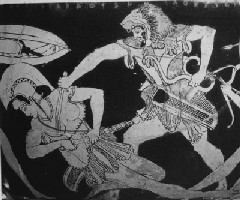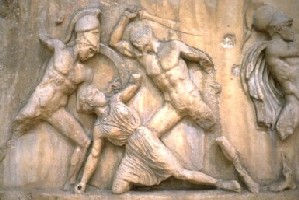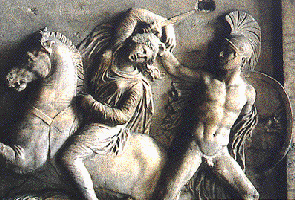



MYSTERY OF THE AMAZONS
The Nature Of The Amazons
|
In view of available data there is no reason to deny reality of the ancient women warriors.
Four kinds of Amazons should be distinguished in accordance with Greek sources:
It's significant that he other Amazonian regions, namely Cappadocia, Libya, and Aegean islands are arid too. Therefore we can assume the female health and the physical strength of those Amazons was based on action licorice, pomegranate, and, probably, other plants having prominent thirst-quenching properties. Those plant ought to secure the phonomenon of the women-warrioirs because the are rich in substances identical to female sex hormones (estrogens), and retain water. Lack of estrogens and of water retention are two main symptoms of the common female hormonal disturbance. Besides, the aridity of Amazon's countries makes think that the historically know Amazons presented only remains of earlier cultures, which disappeared on account formation of the deserts or steppes. According to common notion dating back from the Antiquity, and nourished by modern feminists, Amazons were physically strong misandrist women able to stand up for themselves, and to train the coarse men to the respect for women.
It's significant that these examples are related to Aegean regions concern apparently Aegean Amazons. And although in case of Theseus Cappadocian Amazons are meant, we can allude that originally Aegean Amazons were implied as he arrived to them by sea.
Thus, all things considered, the Amazons were mere healthy, robust women of that barbaric epoch.
It's significant that Artemis
was regarded as a goddess of the Moon that affects female physiology, and as the
divine patron of midwives
There are also some indications of their natural convertible infertile. And the Amazons just ought to be infertile as far as they were healthy and the real female health implies infertility. The Amazons' health apparently was based on vegetarianism and proper use of licorice. So, according to the legends, Amazons had domesticated horse, which suggests friendly attitude to the animals. Also Amazon goddess Artemis was worshiped as patron of animals (later changed into patron of hunters). Besides, she together with her brother Apollo was offered to with bloodless sacrifices at their main temple in Delos island.
In addition, its significant that vegetarianism was enough rife in Ancient Greece and Roma — successors of the Amazon culture. However, despite all their health and power, Amazons were overwhelmed by unhealthy but aggressive and intensively multiplying peoples greedy for Amazons' prosperity, and exiled from their homeland. The following extract from Iliad (III, 184 - 190) seems to confirm this: I went to Phrygia once, the land of vines and galloping horses, and learnt how numerous the Phrygians are when I saw the armies of Otreus and King Mygdon encamped by the River Sangarios. I was their ally and I bivouacked with them that time the Amazons, who fight like men, came up to attack. But even they were not as many as these Achaeans with their flashing eyesOnly some posterity was left assimilated in various peoples, the same Ancient Greeks who were formed from the rest of the Amazonian people and their conquerors - Achaeans. The theme of the former fight against Amazons, named Amazonomachy, was very popular in later Ancient Greek art and epos, which evidently stemmed from the eulogies of the conquerors. |
 |
 |
 |
|
The latter characterizes brute nature of Amazon's enemies rather than beauty of Amazon women. This episode just embodies the ambivalent attitude to the Amazonian women. On one hand, they were appreciated due to their beauty, and on the other, their bearing not affected by the hormonal disturbance excited hatred in the barbaric neighbors. Besides, the wealth created by the healthy Amazonian society compelled such neighbors' jealousy and craving. Fortunately, great part of Amazonian nation escaped from their homeland and settled in new places, mainly in Eurasian steppes (the Scythian Amazons) and neighbor areas. This settling is well-known as grandiose spreading of peoples of Indo-European family of languages. It shows that women of the people had become suddenly permanent fertile after the exile from the homeland.
|